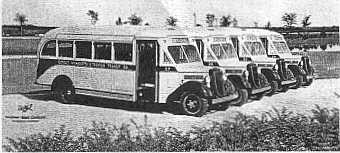
| Typical of the lightweight streamlined FitzJohns of the late 1930's were these four model 215 transit jobs for the Detroit, Wyandotte & Trenton Transit Co. The chassis were Ford BB-18's. The 215 seated 16 to 21 passengers in its various layouts. |
|
was the first FitzJohn body to have a flat front, in the modern style, which was made possible by its mounting on a White 706-M cab-over-engine chassis. Only a few were built, because FitzJohn realized that such styles were in existence to stay. Before long the 250 was joined by a similar city version called the 300, available in a range o~sizes depending on the chassis wheelbase. Then the 250 itself was restyled and upgraded into the 325. White and Chevrolet chassis were the most popular under these bodies.
The Last For Reo FitzJohn's early association with Reo had gradually faded as bodies were built through the 1930's for a wider and wider variety of chassis. But in the fall of 1936, Reo designed a new bus chassis designated 3P7 and called the Reo Pusher. FitzJohn was called on t~ design and build a new type of all-metal city transit body for 25 of these chassis, which were to be operated as Reo demonstrators. The result was the model 350, FitzJohn's last buses for Reo chassis and its first to have the front door ahead of the axle. Of the 25, several are known to have been delivered to City Transport Co. in Lansing and others to Miami.
If additional chassis of this type were built, FitzJohn did not get involved. Reo removed itself from.the bus business for a few years after this venture, during which time the company underwent reorganization, and by the time its line of integral buses was introduced in 1940, FitzJohn was also building complete buses and not just bodies.
| In 1936 and 1937, FitzJohn built 25 bodies for Reo's "Safety Bus." They were the last to be built for Reo chassis. This one is lettered for its eventual operator, City Transport Co. of Lansing. |
|
11